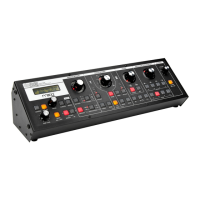Page10
SlimPhattyUser’sManualTheBasics
Page11
SlimPhattyUser’sManualTheBasics
The SP has two operating modes: Master and Preset.
• Master mode allows you to access and change global parameters and other utility options.
A complete list of the Master mode functions and parameters is shown on page 26.
• Preset mode allows you to access the presets and manipulate the sound from the front panel
controls. The Preset mode is the main operating mode for editing and playing the SP. Information
on Preset mode is found on page 23.
When the SP is powered on, it starts up in Preset mode. In this
mode, you select presets using the VALUE encoder. You can rotate
the VALUE encoder to step through the presets in either direction.
Pressing the encoder while rotating increments the preset selection
by +10 or -10 presets. In Preset mode, you’ll see the current preset
displayed on the top line of the LCD display, and a ‘Preset Active’
message on the bottom line. The PRESET button is illuminated in
red. When you edit a preset, the bottom line of the display changes
to ‘Panel Active’ and the PRESET button changes from red to amber,
indicating that you are editing the preset sound. By pressing the
PRESET button you can toggle between the preset (stored) and
edited (panel) sounds. Note that once you change preset numbers,
any edits made to the previous preset will be lost unless the edits
are saved.
Editing a preset is simple. There are four analog editing controls on the front
panel, one for each of the four sound shaping sections (Modulation, Oscilla-
tors, Filter, and Envelope Generators). Each control is surrounded by a ring of
15 LEDs that indicate approximately the stored or edited value of the current
parameter. The parameters for each section are chosen by pushing the switch
for the desired parameter in that section. That switch then becomes illuminated.
Only one parameter can be activated at a time for editing in each section.
Some parameters offer multiple selections (such as the Modulation SOURCE
switch, shown at right). Pressing that switch advances through the six possible
Modulation sources. For the On/Off type switches like GLIDE ON/OFF (above),
1-2 SYNC or OUTPUT ON/OFF, the switch is illuminated when the parameter
is turned on, and goes out when the parameter is turned off.
TECHNOTE:TheSP’seditingcontrolsareactuallyanalogpotentiometers.Whencertain
keyparametersareselected,theanalogcontrolsignalisswitchedtocontrolthatparameter
directly.ThisiscalledRAC™(RealAnalogControl).RACgivestheSParesponsiveness
thatcanonlybeachievedwithanalogcontrolbyprovidingdirectaccesstotheanalog
controlsignalpath;straighttothesynthesizercircuits.RACprovidesresponsiveanalog
controlfortheOsc1&2,FilterCutoff,FilterResonance,EGAmount,OverloadandFilter
EGSustainparameters.
Basic Operation

